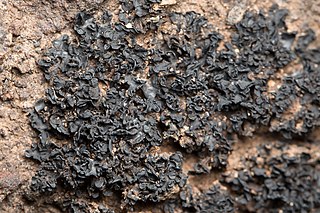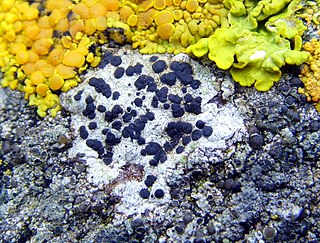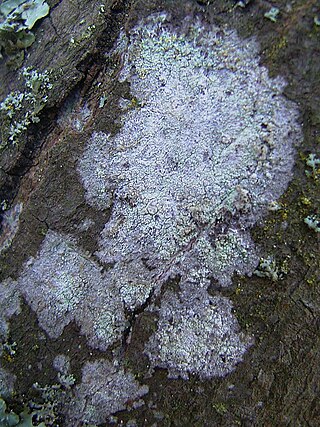Related Research Articles
Scutula is a genus of lichenicolous fungi in the family Ramalinaceae.
Biatorellaceae is a family of lichen-forming fungi in the subclass Lecanoromycetidae. The family is monotypic, and contains the single genus Biatorella, which contains eight species.

The Stereocaulaceae are a family of lichen-forming fungi in the order Lecanorales. It contains five genera. Species of this family are widely distributed in temperate boreal and austral regions.

The Lichinaceae are a family of ascomycete fungi. Most species are lichenized with cyanobacteria, and have a distribution largely in temperate regions.

The Gomphillaceae are a family of lichen-forming fungi in the order Graphidales. Species in this family are found mostly in tropical regions.

Acarospora is a genus of mostly lichen-forming fungi in the family Acarosporaceae. Most species in the genus are crustose lichens that grow on rocks in open and arid places all over the world. They may look like a cobblestone road or cracked up old paint, and are commonly called cobblestone lichens or cracked lichens. They usually grow on rock, but some grow on soil (terricolous) or on other lichens. Some species in the genus are fungi that live as parasites on other lichens. Acarospora is a widely distributed genus, with about 128 species according to a 2008 estimate.

Micarea is a genus of lichenized fungi in the family Pilocarpaceae. The widely distributed genus contains 126 species and new species are described actively. Species in the genus are crustose lichens and their photobiont is a single-celled green alga.

Diplotomma is a genus of lichenized fungi in the family Caliciaceae. The genus has a widespread distribution and contains about 29 species. The genus was circumscribed by Julius von Flotow in 1849. It was later wrapped into Buellia before being segregated from that genus by David Hawksworth in 1980.

Lecidella is a genus of crustose lichens in the family Lecanoraceae.

Bryoria is a genus of lichenized fungi in the family Parmeliaceae. Many members of this genus are known as horsehair lichens. The genus has a widespread distribution, especially in boreal and cool temperate areas.

Phlyctis is a genus of lichenized fungi in the order Gyalectales, and the type genus of the family Phlyctidaceae. Members of the genus are commonly called blemished lichens.

Scytinium is a genus of lichen-forming fungi in the family Collemataceae. It has 49 species. These lichens are typically found on basic rocks, soil, and trees, occasionally in association with mosses. Despite the morphological and ecological diversity within Scytinium, its species share similar ascospore features, such as shape and septation, as well as a small to medium-sized thallus with at least a partial cortex.
The Melaniellaceae are a family of fungi in the division Basidiomycota and order of Doassansiales. The family contains 1 genera and 2 species. They have a distribution in south and south-east Asia.
Thelenellaceae is a family of lichen-forming fungi. It is the sole family in the monotypic order Thelenellales, and contains three genera and about 50 species.
Helocarpaceae is a family of lichen-forming fungi in the subclass Lecanoromycetidae. The family is monotypic, and contains the single genus Helocarpon.
Pisorisporiales is an order of fungi within the phylum of Ascomycota and in the class Sordariomycetes and subdivision of Pezizomycotina and also its own subclass Pisorisporiomycetidae.
Pleurothecium is a genus of terrestrial and freshwater fungi in the family Pleurotheciaceae and the monotypic order Pleurotheciales. It is typified by Pleurothecium recurvatum as the type species (Morgan) Höhn, which has the synonym of Carpoligna pleurotheciiF.A. Fernández & Huhndorf, Mycologia 9: 253. 1999.

Fulvophyton is a genus of lichen-forming fungi in the family Roccellographaceae. It has 11 species. Fulvophyton is characterised by its crust-like thallus, which is often pale yellowish-brown in colour. This genus features a photobiont from the green algal genus Trentepohlia and exhibits a unique arrangement of reproductive structures.
References
- ↑ Körber, G.W. 1855. Systema lichenum Germaniae. :1-458
- ↑ Naturgeschichte der Flechten 1: 251–253 (1825)
- ↑ Lumbsch TH, Huhndorf SM. (December 2007). "Outline of Ascomycota – 2007". Myconet. Chicago, USA: The Field Museum, Department of Botany. 13: 1–58. Archived from the original on 2009-03-18.
- ↑ Dr. Suharno, M.Si., Dra. Supeni Sufaati, M.Sc., Dr. Puguh Sujarta, M.Si. and Dra. Verena Agustini, M.Sc., Liken (lumut Kerak) Struktur Morfologi, Anatomi, Fungsi Ekologi, dan Manfaat ... (2021) , p. 250, at Google Books
- 1 2 P. F. Cannon and P. M. Kirk (Editors) Fungal Families of the World (2007) , p. 244, at Google Books
- ↑ Geoffrey Clough Ainsworth Ainsworth & Bisby's Dictionary of the Fungi (2008) , p. 477, at Google Books
- ↑ "Sordariomycetes". www.sordariomycetes.org. Retrieved 31 December 2022.
- ↑ Chethana, Thilini (8 November 2022). "Obryzaceae - Facesoffungi number: FoF 05205". Faces Of Fungi. Retrieved 31 December 2022.
- ↑ "Obryzum Wallr". www.gbif.org. Retrieved 31 December 2022.
- ↑ "Obryzum corniculatum". The British Lichen Society. Retrieved 31 December 2022.
- ↑ "Obryzum - Search Page". www.speciesfungorum.org. Species Fungorum. Retrieved 31 October 2022.